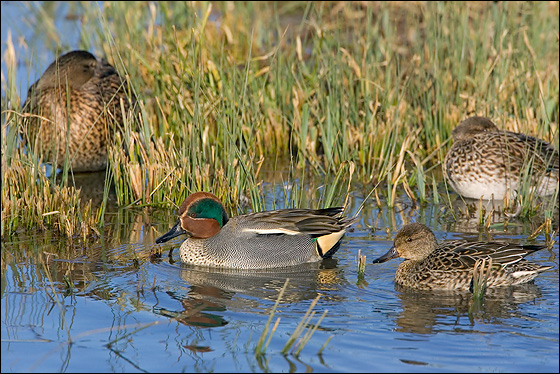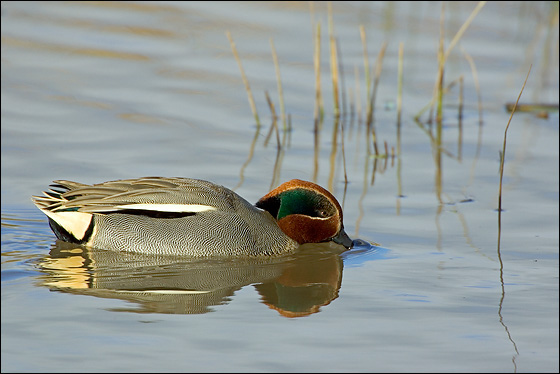Teal
No duck in Europe is as small or as agile as the Teal. Flocks of these birds can rise vertically from the water, apparently with little effort. They don’t need a run-up but instead “spring” into the air with a tremendous kick of the feet. Once airborne they can twist and turn, and they move with such quick wing-beats that groups are easily confused with tightly-knit packs of waders.
When feeding the Teal specialises in working the mud rather than the water itself. Typically it walks forward on a muddy surface with its head down and bill level with its feet, ingesting the ooze and filtering edible particles from it. Items taken include a wide variety of plants and animals, but in winter the diet narrows somewhat, and most individuals get by mainly on seeds. Teal also swim to feed, both by picking from the water surface or by up-ending below it. Not surprisingly the Teal’s shallow water habitat quickly freezes over when the temperature falls in winter, and if this happens the birds soon evacuate a non-breeding area to head west or south for a milder climate.
Being so manoeuvrable has enabled the Teal to specialise on utilising small or very small bodies of water throughout the year. The typical breeding habitat is a tiny freshwater pool, bog or stream, often quite an isolated one, and sites surrounded by trees or bushes are perfectly acceptable. So long as the Teal has some shallow water available with ample fringing vegetation, the size of the area matters little, and access is rarely a problem. When not breeding the Teal is more catholic in its choice of habitat, visiting any types of water large and small, and expanding into estuarine and even coastal waters.
When feeding the Teal specialises in working the mud rather than the water itself. Typically it walks forward on a muddy surface with its head down and bill level with its feet, ingesting the ooze and filtering edible particles from it. Items taken include a wide variety of plants and animals, but in winter the diet narrows somewhat, and most individuals get by mainly on seeds. Teal also swim to feed, both by picking from the water surface or by up-ending below it. Not surprisingly the Teal’s shallow water habitat quickly freezes over when the temperature falls in winter, and if this happens the birds soon evacuate a non-breeding area to head west or south for a milder climate.


